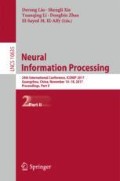Abstract
Convolutional neural networks (CNNs) have been widely applied in the field of computer vision. Nowadays, the architecture of CNNs is becoming more and more complex, involving more layers and more neurons per layer. The augmented depth and width of CNNs will lead to greatly increased computational and memory costs, which may limit CNNs practical utility. However, as demonstrated in previous research, CNNs of complex architecture may contain considerable redundancy in terms of hidden neurons. In this work, we propose a magnitude based binary neuron pruning method which can selectively prune neurons to shrink the network size while keeping the performance of the original model without pruning. Compared to some existing neuron pruning methods, the proposed method can achieve higher compression rate while automatically determining the number of neurons to be pruned per hidden layer in an efficient way.
Access this chapter
Tax calculation will be finalised at checkout
Purchases are for personal use only
Notes
- 1.
The fine-tuning process is the same as https://github.com/dmlc/mxnet-notebooks/blob/master/python/how_to/finetune.ipynb.
References
Krizhevsky, A., Sutskever, I., Hinton, G.E.: Imagenet classification with deep convolutional neural networks. In: Advances in Neural Information Processing Systems, pp. 1097–1105 (2012)
Ren, S., He, K., Girshick, R., Sun, J.: Faster r-cnn: Towards real-time object detection with region proposal networks. In: Advances in Neural Information Processing Systems, pp. 91–99 (2015)
Denil, M., Shakibi, B., Dinh, L., Ranzato, M., de Freitas, N.: Predicting parameters in deep learning. In: Nips, pp. 2148–2156 (2013)
Ba, L., Caurana, R.: Do deep nets really need to be deep? In: Advances in Neural Information Processing Systems 2014, pp. 1–6 (2014)
Chen, W., Wilson, J.T., Tyree, S., Weinberger, K.Q., Chen, Y.: Compressing Convolutional Neural Networks. arXiv:1506.04449, pp. 1–9 (2015)
Chen, W., Wilson, J.T., Tyree, S., Weinberger, K.Q., Chen, Y.: Compressing neural networks with the hashing trick. CoRR, abs/1504.04788 (2015)
Han, S., Mao, H., Dally, W.J.: Deep compression - compressing deep neural networks with pruning, trained quantization and Huffman coding. In: Iclr, pp. 1–13 (2016)
Han, S., Pool, J., Tran, J., Dally, W.J.: Learning both weights and connections for efficient neural networks. In: Nips, pp. 1135–1143 (2015)
Hinton, G., Vinyals, O., Dean, J.: Distilling the knowledge in a neural network. In: NIPS 2014 Deep Learning Workshop, pp. 1–9 (2015)
Hu, H., Peng, R., Tai, Y.W., Tang, C.K.: Network Trimming: A Data-Driven Neuron Pruning Approach towards Efficient Deep Architectures (2016)
Jaderberg, M., Vedaldi, A., Zisserman, A.: Speeding up Convolutional Neural Networks with Low Rank Expansions. arXiv preprint arXiv:1405.3866, p. 7 (2014)
Lebedev, V., Ganin, Y., Rakhuba1, M., Oseledets, I., Lempitsky, V.: Speeding-up convolutional neural networks using fine-tuned CP-Decomposition. In: Iclr, pp. 1–10 (2015)
Li, H., Kadav, A., Durdanovic, I., Samet, H., Graf, H.P.: Pruning Filters for Efficient ConvNets (2016)
Mariet, Z., Sra, S.: Diversity networks. In: Iclr, pp. 1–11 (2015)
Romero, A., Ballas, N., Kahou, S.E., Chassang, A., Gatta, C., Bengio, Y.: FitNets: Hints for Thin Deep Nets, pp. 1–13 (2014)
Srinivas, S., Babu, R.V., Education, S.: Data-free Parameter Pruning for Deep Neural Networks, pp. 1–12 (2015)
Szegedy, C., Vanhoucke, V., Ioffe, S., Shlens, J., Wojna, Z.: Rethinking the inception architecture for computer vision. In: Proceedings of the IEEE Conference on Computer Vision and Pattern Recognition, pp. 2818–2826 (2016)
He, T., Fan, Y., Qian, Y., Tan, T., Yu, K.: Reshaping deep neural network for fast decoding by node-pruning. In: 2014 IEEE International Conference on Acoustics, Speech and Signal Processing (ICASSP), pp. 245–249. IEEE (2014)
LeCun, Y., Bottou, L., Bengio, Y., Haffner, P.: Gradient-based learning applied to document recognition. Proc. IEEE 86(11), 2278–2324 (1998)
Simonyan, K., Zisserman, A.: Very deep convolutional networks for large-scale image recognition. arXiv preprint arXiv:1409.1556 (2014)
Griffin, G., Holub, A., Perona, P.: Caltech-256 Object Category Dataset (2007)
Chen, T., Li, M., Li, Y., Lin, M., Wang, N., Wang, M., Xiao, T., Xu, B., Zhang, C., Zhang, Z.: Mxnet: a flexible and efficient machine learning library for heterogeneous distributed systems. arXiv preprint arXiv:1512.01274 (2015)
Acknowledgements
This research is supported by Chinese Scholarship Council.
Author information
Authors and Affiliations
Corresponding author
Editor information
Editors and Affiliations
Rights and permissions
Copyright information
© 2017 Springer International Publishing AG
About this paper
Cite this paper
Zhang, B., Qin, A.K., Chan, J. (2017). An Efficient Binary Search Based Neuron Pruning Method for ConvNet Condensation. In: Liu, D., Xie, S., Li, Y., Zhao, D., El-Alfy, ES. (eds) Neural Information Processing. ICONIP 2017. Lecture Notes in Computer Science(), vol 10635. Springer, Cham. https://doi.org/10.1007/978-3-319-70096-0_20
Download citation
DOI: https://doi.org/10.1007/978-3-319-70096-0_20
Published:
Publisher Name: Springer, Cham
Print ISBN: 978-3-319-70095-3
Online ISBN: 978-3-319-70096-0
eBook Packages: Computer ScienceComputer Science (R0)

